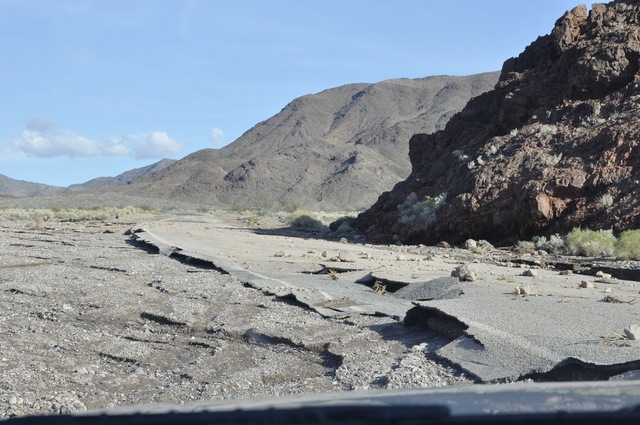
Almost 10 months after a wild storm washed out a stretch of road linking Shoshone and Death Valley National Park, the roadway reopened last week.
Badwater Road, connecting the national park with its nearby gateway town, fully opened to motorists last week. Despite the reopening, several areas of the park are still in need of road repair work and infrastructure fixes, caused by flash floods in October.
A string of storms between Oct. 4 and Oct. 18 caused extensive flash flood damage in Death Valley. In one location, 2.7 inches of rain fell in five hours, exceeding Death Valleys average precipitation for a year in that short time period.
Badwater Road is the main paved road in the southern end of Death Valley National Park and was reopened in sections.
National Park Service road crews cleared large amounts of dirt and rock to open the northern section of Badwater Road by early November. This allowed access to popular park destinations like Badwater Basin, the lowest elevation in North America, sitting at 282 feet below sea level.
The section of Badwater Road near Jubilee Pass was heavily damaged, with around a half-mile of pavement and road base washed away in multiple sections of the road.
The Federal Highway Administration funded the repair work and William Kanayan Construction began repairs in May, under a contract with the Federal Highway Administration.
To avoid the extreme temperatures seen in Death Valley, the majority of the work was done at night.
With Badwater Road connecting to CA-178 and being the primary entrance into the southern section of Death Valley National Park, the ten-month closure affected hundreds of thousands of park visitors and the economy of both Shoshone and Tecopa.
Most other park roads that were affected by the extreme storms last year have since reopened.
The exception is the Grapevine Canyon section of Scottys Castle Road, which was the most extensively damaged road and is still closed.
The flood was about a quarter the size of the Colorado River. It was so huge that it changed the shape of the canyon floor, said Abby Wines, Death Valley Park spokesperson. That means it wouldnt be smart to just replace the road like it was. Engineers are redesigning sections of the road.
With the design work and environmental compliance likely to take some time, construction likely wont begin there until 2017.
Scottys Castle and Grapevine Canyon are both closed to public entry. Park managers estimate the repairs to be complete and the area reopening to take place in 2019.
Around 120,000 visitors travel through Grapevine Canyon per year, with more than 50,000 visitors per year taking an hour-long ranger-guided living history tour of Scottys Castle each year before the flood.
There was a flurry of work in the first months after the flood, Wines said. We borrowed trail crews and fire crews from other parks and got the mud shoveled out of the historic buildings. That made the site look a lot better.
However, most of the work is still to be done and needs to be carefully planned. Several historic buildings were damaged, including the garage/longshed, which houses the Scottys Castle Visitor Center. The damage to the visitor center is obvious, Wines said. It looks like a monster punched the wall. We had to dig out four feet of mud and rocks.
Some of the damage is less noticeable than other damage, but is just as crucial to repair before the site can be reopened to the public.
The flood destroyed the water system and washed away 4,000 feet of water line that was buried in the wash. Repairs have begun on the water system.
In addition, Southern California Edison replaced over 20 power poles, with repairs to electrical wiring in the district to start in a couple of weeks to restore power to the buildings. The sewer system was also damaged and needs to be replaced.
The estimated cost of recovering from these floods, including road repairs, is $31 million. Critical funding is coming from federal sources via the National Park Service and Federal Highway Administration.
Death Valley Natural History Association, a nonprofit park partner, is coordinating donations to assist with Scottys Castle projects through their website, www.dvnha.org.
Contact reporter Mick Akers at makers@pvtimes.com. Follow @mickakers on Twitter.